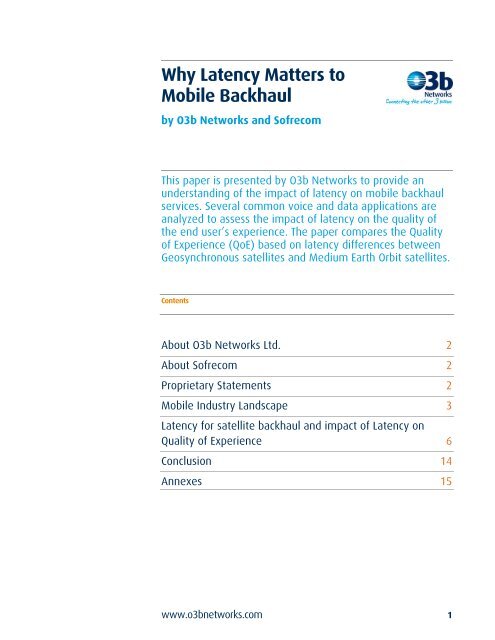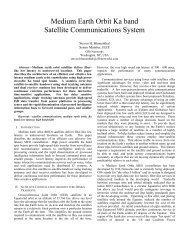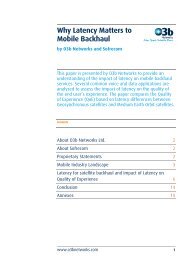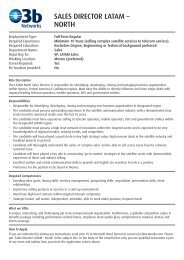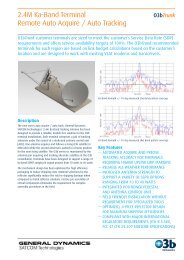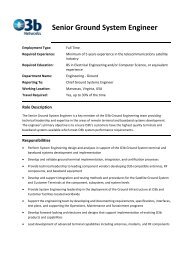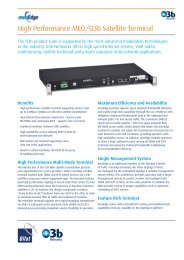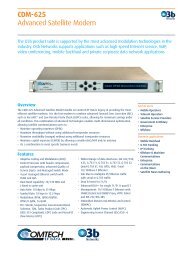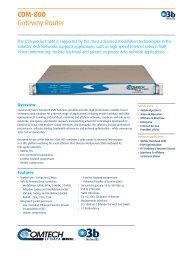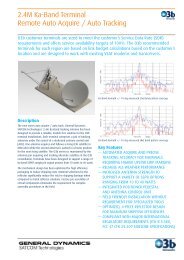Why Latency Matters to Mobile Backhaul - O3b Networks
Why Latency Matters to Mobile Backhaul - O3b Networks
Why Latency Matters to Mobile Backhaul - O3b Networks
Create successful ePaper yourself
Turn your PDF publications into a flip-book with our unique Google optimized e-Paper software.
<strong>Why</strong> <strong>Latency</strong> <strong>Matters</strong> <strong>to</strong><br />
<strong>Mobile</strong> <strong>Backhaul</strong><br />
by <strong>O3b</strong> <strong>Networks</strong> and Sofrecom<br />
This paper is presented by <strong>O3b</strong> <strong>Networks</strong> <strong>to</strong> provide an<br />
understanding of the impact of latency on mobile backhaul<br />
services. Several common voice and data applications are<br />
analyzed <strong>to</strong> assess the impact of latency on the quality of<br />
the end user’s experience. The paper compares the Quality<br />
of Experience (QoE) based on latency differences between<br />
Geosynchronous satellites and Medium Earth Orbit satellites.<br />
Contents<br />
About <strong>O3b</strong> <strong>Networks</strong> Ltd. 2<br />
About Sofrecom 2<br />
Proprietary Statements 2<br />
<strong>Mobile</strong> Industry Landscape 3<br />
<strong>Latency</strong> for satellite backhaul and impact of <strong>Latency</strong> on<br />
Quality of Experience 6<br />
Conclusion 14<br />
Annexes 15<br />
www.o3bnetworks.com 1
<strong>Why</strong> <strong>Latency</strong> <strong>Matters</strong> <strong>to</strong> <strong>Mobile</strong> <strong>Backhaul</strong><br />
About <strong>O3b</strong> <strong>Networks</strong> Ltd.<br />
<strong>O3b</strong> <strong>Networks</strong> is a global satellite service provider building a new fiberquality,<br />
global Internet backbone for telecommunications opera<strong>to</strong>rs,<br />
internet service providers, enterprise and Government cus<strong>to</strong>mers in<br />
emerging markets. The <strong>O3b</strong> <strong>Networks</strong> system will combine the global reach<br />
of satellite with the speed of a fiber-optic network providing billions of<br />
consumers and businesses across 177 countries with low-cost, high-speed,<br />
low latency internet and mobile connectivity. With investments and<br />
operational support from SES, Google Inc. Liberty Global, Inc. HSBC Principal<br />
Investments, Northbridge Venture Partners and Allen & Company, the <strong>O3b</strong><br />
system will provide telcos and ISPs with a low-cost, high-speed alternative<br />
<strong>to</strong> connect their 3G, WiMAX and fixed-line networks <strong>to</strong> the rest of the<br />
world. <strong>O3b</strong> <strong>Networks</strong> is headquartered in<br />
St. John, Jersey, Channel Islands.<br />
About Sofrecom<br />
Sofrecom, a France Telecom – Orange Group Company, is a world leader in<br />
telecommunications consulting and engineering.<br />
With more than 45 years international experience, Sofrecom has acquired a<br />
unique know-how of successfully managing change in the<br />
telecommunications industry. Sofrecom has led major transformation<br />
programs and has participated in the green field launch of multiple<br />
opera<strong>to</strong>rs, including all Orange mobile opera<strong>to</strong>rs over the past 5 years.<br />
This rich international experience provides Sofrecom with an unparalleled<br />
expertise in all areas of telecommunications and makes it the natural<br />
strategic partner for opera<strong>to</strong>rs, governments, inves<strong>to</strong>rs and international<br />
financial organizations.<br />
Proprietary Statements<br />
<strong>O3b</strong> provides this information in good faith, and has taken all reasonable<br />
steps <strong>to</strong> ensure its accuracy and completeness as of the date hereof.<br />
However, <strong>O3b</strong> expressly disclaims any and all liability which may be based<br />
on the use of such information, errors therein, changes and omissions<br />
there<strong>to</strong>. <strong>O3b</strong> shall not be liable for damages of any kind, including special,<br />
incidental or consequential damages or damages for loss of goodwill or loss<br />
of prospective profits, on account of omissions or errors contained herein.<br />
<strong>O3b</strong>® and <strong>O3b</strong> <strong>Networks</strong>® are registered trademarks of <strong>O3b</strong> <strong>Networks</strong><br />
Limited. Other product names, company names, brand names, and trade<br />
names mentioned within the corporate information center may be the<br />
trademarks of their respective holders. All rights in the service marks,<br />
company names, trade names, and logos used for the products or services<br />
of <strong>O3b</strong> or of third parties belong exclusively <strong>to</strong> <strong>O3b</strong> or their respective<br />
owners, and are protected from reproduction, imitation, dilution, or<br />
confusing or misleading uses under national and international trademark<br />
and copyright laws.<br />
www.o3bnetworks.com 2
<strong>Why</strong> <strong>Latency</strong> <strong>Matters</strong> <strong>to</strong> <strong>Mobile</strong> <strong>Backhaul</strong><br />
<strong>Mobile</strong> Industry Landscape<br />
The <strong>Mobile</strong> industry is changing rapidly, as it evolves from 2G <strong>to</strong> 3G and on<br />
<strong>to</strong> 4G networks. This evolution is driven by the need <strong>to</strong> provide better<br />
performance in three main areas:<br />
− Provide subscribers with higher data rates<br />
− Support a wider variety of end user applications<br />
− Reduce the latency of the mobile network<br />
Increasing sales of 3G smartphones, USB modems, tablets and PCs with<br />
built in wireless radios is pushing data traffic on mobile networks <strong>to</strong> record<br />
levels. While email, social networks and Internet browsing are very popular<br />
among nomadic users, the deployment of mobile broadband services has<br />
the biggest impact on network traffic. In rural areas, mobile networks are<br />
often the only way <strong>to</strong> support applications his<strong>to</strong>rically delivered over<br />
copper based networks. Video streaming is a major contribu<strong>to</strong>r <strong>to</strong> the boost<br />
in traffic, with the success of Internet services such as YouTube and<br />
DailyMotion. The latest Cisco Visual Networking Index forecasts<br />
unprecedented global mobility demand.<br />
Figure 1 – <strong>Mobile</strong> Data Growth<br />
www.o3bnetworks.com 3
<strong>Why</strong> <strong>Latency</strong> <strong>Matters</strong> <strong>to</strong> <strong>Mobile</strong> <strong>Backhaul</strong><br />
Data services are projected <strong>to</strong> grow by a staggering 78% annually over just<br />
the next four years. It is also clear that the mix of applications is changing,<br />
particularly with the shift <strong>to</strong>wards mobile video.<br />
While the increasing data rates and the changing application mix are easily<br />
unders<strong>to</strong>od, the impact of latency on performance requires a closer look.<br />
How does latency affect application quality and the end user experience<br />
We will explain the significant difference lower latency can make in the<br />
delivery of voice, video and data services. We will strive <strong>to</strong> answer the<br />
question: <strong>Why</strong> does latency matter <strong>to</strong> mobile backhaul<br />
QoE is the new challenge<br />
Fierce market competition is driving network opera<strong>to</strong>rs <strong>to</strong> identify true<br />
differentia<strong>to</strong>rs capable of separating them from the rest. The innova<strong>to</strong>rs, in<br />
turn, are intensifying efforts <strong>to</strong> boost the Quality of Experience for their<br />
subscribers. As a result, QoE is now one of the latest buzzwords in the<br />
mobile industry.<br />
The QoE experienced by a mobile subscriber for a voice call is influenced by<br />
a number of fac<strong>to</strong>rs, including mouth-<strong>to</strong>-ear delay, voice call set-up delay<br />
and audio quality/noise. The QoE for data services is influenced by web<br />
page response time and download speeds.<br />
Network segment QoS indica<strong>to</strong>rs<br />
For mobile network elements, such as components of the access, backhaul<br />
and core networks, several indica<strong>to</strong>rs are used <strong>to</strong> define and moni<strong>to</strong>r the<br />
target performance.<br />
− <strong>Latency</strong> - <strong>Latency</strong> is the duration of time for information <strong>to</strong> transit from<br />
one point <strong>to</strong> another point of the network. Depending on the type of<br />
service, it can be measured either in one direction (Ear-<strong>to</strong>-mouth or<br />
One-way latency) or as a round trip time (RTT or Two-way latency).<br />
− Jitter - Jitter is the variation of the measured latency. It is generated by<br />
the variation of the load on the network due <strong>to</strong> usage levels.<br />
− Packet loss - Packet loss is the ratio of packets being lost during transit<br />
from one point <strong>to</strong> another point of the network. It is generally caused<br />
by transmission errors, congestion of links, faults or the routing process.<br />
In modern IP based networks jitter is easily compensated for by<br />
implementing buffers in the endpoints. Likewise packet loss is very low on<br />
<strong>to</strong>day’s networks, which employ high performance error correction codes<br />
such as LDPC which is used in DVB-S2. <strong>Latency</strong>, however, is more difficult <strong>to</strong><br />
avoid. The root cause is linked <strong>to</strong> long distances and the speed of light.<br />
Once present in a system, latency cannot be removed. This is exactly why<br />
the mobile industry has consistently engineered each new technology<br />
generation with lower latency, as seen in Figure 2.<br />
www.o3bnetworks.com 4
<strong>Why</strong> <strong>Latency</strong> <strong>Matters</strong> <strong>to</strong> <strong>Mobile</strong> <strong>Backhaul</strong><br />
Figure 2 – <strong>Latency</strong> in <strong>Mobile</strong> Technology Evolution<br />
Every new mobile technology generation has reduced network latency. The<br />
right side of the chart shows the latency of satellite backhaul for traditional<br />
GEO satellite and <strong>O3b</strong>’s MEO constellation. It is easy <strong>to</strong> see that for later<br />
generation mobile networks satellite backhaul is the dominant contribu<strong>to</strong>r<br />
<strong>to</strong> end-<strong>to</strong>-end latency and the resulting subscriber QoE.<br />
www.o3bnetworks.com 5
<strong>Why</strong> <strong>Latency</strong> <strong>Matters</strong> <strong>to</strong> <strong>Mobile</strong> <strong>Backhaul</strong><br />
<strong>Latency</strong> for satellite backhaul and impact of <strong>Latency</strong> on<br />
Quality of Experience<br />
End-<strong>to</strong> End latency Model<br />
Each network component contributes <strong>to</strong> latency. The chart below, extracted<br />
from a study by Nokia Siemens <strong>Networks</strong> (NSN), shows the latency<br />
distribution for a mobile network (exclusive of backhaul or international<br />
network latency).<br />
Figure 3 – <strong>Latency</strong> Distribution for <strong>Mobile</strong> Network (NSN 1 )<br />
(1) Extracted from “The impact of latency on application performance, Nokia Siemens <strong>Networks</strong>”<br />
With each release there has been a tremendous engineering effort <strong>to</strong><br />
optimize each network element and terrestrial link <strong>to</strong> provide the lowest<br />
possible latency. Individual components have been optimized, frame<br />
lengths reduced, pro<strong>to</strong>cols streamlined, and in the case of LTE, an entire<br />
network layer has been eliminated.<br />
The satellite backhaul element is much more difficult <strong>to</strong> optimize.<br />
Technologies, such as ComtechEFData’s VersaFEC, have improved the<br />
modem processing delay, but the fundamental distance of the path length<br />
<strong>to</strong> the satellite is what drives the delay.<br />
www.o3bnetworks.com 6
<strong>Why</strong> <strong>Latency</strong> <strong>Matters</strong> <strong>to</strong> <strong>Mobile</strong> <strong>Backhaul</strong><br />
<strong>Mobile</strong> Service Classification<br />
From a mobile network perspective, the ITU and the 3GPP have grouped<br />
the end-user services in<strong>to</strong> four classes based on their sensitivity <strong>to</strong> latency.<br />
Figure 4 – User services classification<br />
This paper focuses on the three major service classes for mobile opera<strong>to</strong>rs<br />
and the practical impact of latency on:<br />
− Conversational Voice<br />
− Interactive Applications, such as cloud-based applications, online<br />
shopping, instant messenger and online search.<br />
− Non real-time data, such as web browsing, email SMS/Text messaging,<br />
file sharing, and video streaming.<br />
Conversational Voice Services<br />
Voice quality is measured in the ITU model by the R fac<strong>to</strong>r, which can also<br />
be translated in<strong>to</strong> a Mean Opinion Score (MOS) score, a scale widely used<br />
<strong>to</strong> evaluate the quality of a voice call. The MOS score and voice call quality<br />
degrades rapidly when the ear-<strong>to</strong>-mouth latency increases beyond 200ms.<br />
Annex 1 provides a detailed explanation of the ITU model.<br />
A latency comparison for a UMTS Release 99 voice call for two cases using<br />
MEO and GEO satellites is shown below.<br />
Figure 5 – End <strong>to</strong> end latency distribution for a voice call with <strong>O3b</strong> satellite backhaul<br />
www.o3bnetworks.com 7
<strong>Why</strong> <strong>Latency</strong> <strong>Matters</strong> <strong>to</strong> <strong>Mobile</strong> <strong>Backhaul</strong><br />
Figure 6 – End <strong>to</strong> end latency distribution for a voice call with GEO satellite backhaul.<br />
For <strong>O3b</strong>’s MEO constellation, the fiber return path adds 30ms of latency,<br />
representing the case of more than 5000km of optical fiber.<br />
The following diagram shows the resulting MOS scores for these two cases.<br />
Figure 7 – Voice Quality / MOS score degradation as a function of latency<br />
A side-by-side comparison of end-<strong>to</strong>-end latency values results in an MOS<br />
score of 4.4 for <strong>O3b</strong>’s MEO constellation and a MOS score of 3.8 for<br />
traditional GEO satellite.<br />
www.o3bnetworks.com 8
<strong>Why</strong> <strong>Latency</strong> <strong>Matters</strong> <strong>to</strong> <strong>Mobile</strong> <strong>Backhaul</strong><br />
Interactive user services<br />
The impact of latency on interactive services is more subjective. As the<br />
delay increases, the applications continue <strong>to</strong> function. However, the sense<br />
of immediacy and the usability degrades. At some point, the user becomes<br />
less <strong>to</strong>lerant of waiting for the response, eventually giving up and moving<br />
on <strong>to</strong> something more satisfying. A great deal of research has been done<br />
by companies whose revenues are impacted when users abandon their<br />
transactions.<br />
The importance of latency on web commerce was first showcased by Zona<br />
Research in 1999 with the popular “8-second rule”. Zona found that more<br />
than $4 billion e-commerce sales were lost due <strong>to</strong> poor site performance,<br />
which ultimately led <strong>to</strong> transaction abandonment. In a follow up study in<br />
2006, Jupiter Research concluded that the threshold had been reduced <strong>to</strong> 4<br />
seconds, as more users experience the performance of high-speed<br />
broadband.<br />
Google discovered that the number of web searches and ad revenue<br />
declined as they increased the number of user search results from 10 <strong>to</strong> 30.<br />
Further research found the result was due <strong>to</strong> the additional time required <strong>to</strong><br />
compute and present more results <strong>to</strong> the user. Increasing the results from<br />
10 <strong>to</strong> 30 required an additional 500ms <strong>to</strong> compute and resulted in a 25%<br />
drop in the number of searches done by users. Following this initial study,<br />
Google performed additional tests focused exclusively on the latency. They<br />
injected artificial delay in<strong>to</strong> the display of the search results. An increase in<br />
display time of 400ms actually decreased the number of searches per users<br />
by 0.44% <strong>to</strong> 0.76%. While these drops in usage appear small, they had a<br />
direct and meaningful impact on ad revenue.<br />
Similarly with Amazon: “We tried delaying the page in increments of<br />
100 milliseconds and found that even very small delays would result in<br />
substantial and costly drops in revenue,” said researcher Greg Linden.<br />
Linden provides a precise figure: -1% sales for 100ms or more latency.<br />
(Greg Linden in “Make Data Useful”, Data Mining course Stanford in 2006).<br />
Steve Souders from O’Reilly adds more examples in a blog posting<br />
http://radar.oreilly.com/2009/07/velocity-making-your-site-fast.html.<br />
In “Performance Related Changes and their User Impact,” Eric Schurman<br />
(Bing) explains that Bing researchers have conducted tests adding a static<br />
delay of 50 ms <strong>to</strong> 2 seconds <strong>to</strong> their servers. A negative impact on the Bing<br />
performance indica<strong>to</strong>rs resulted as soon as the delay increased by more<br />
than 50ms. The degradation noticed was linear.<br />
www.o3bnetworks.com 9
<strong>Why</strong> <strong>Latency</strong> <strong>Matters</strong> <strong>to</strong> <strong>Mobile</strong> <strong>Backhaul</strong><br />
Distinct<br />
Queries/User<br />
Query<br />
Refinement Revenue/User Any Clicks Satisfaction<br />
Time <strong>to</strong> Click<br />
(increase<br />
in ms)<br />
50ms – – – – – –<br />
200ms – – – -0.3% -0.4% 500<br />
500ms – -0.6% -1.2% -1.0% -0.9% 1200<br />
1000ms -0.7% -0.9% -2.8% -1.9% -1.6% 1900<br />
2000ms -1.8% -2.1% -4.3% -4.4% -3.8% 3100<br />
Figure 8 – Bing table of latency impact for user search service<br />
Phil Dixon (Shopzilla.com) presented results from the Shopzilla site<br />
redesign at the Velocity 2009 Conference. He illustrated that a reduction in<br />
page load time from 7 <strong>to</strong> 2 seconds resulted in a 25% increase in page<br />
views and a 7-12% increase in revenue.<br />
Below, a mobile subscriber is using a HSPA session over a satellite backhaul<br />
<strong>to</strong> access Internet data services.<br />
Figure 9 - End <strong>to</strong> end latency for data services using <strong>O3b</strong> backhaul<br />
Figure 10 - End <strong>to</strong> end latency data services using GEO satellite backhaul<br />
www.o3bnetworks.com 10
<strong>Why</strong> <strong>Latency</strong> <strong>Matters</strong> <strong>to</strong> <strong>Mobile</strong> <strong>Backhaul</strong><br />
The increase in latency of 420ms between <strong>O3b</strong>’s MEO solution and a GEO<br />
satellite has a significant impact on interactive services.<br />
As demonstrated, revenue loss is a significant consequence of the quality<br />
degradation of a users’ experience caused by download delays. End users<br />
perceive latency increases of a few hundred milliseconds in a negative<br />
way, which translates in<strong>to</strong> a loss of business for providers and advertisers.<br />
Users are unaware whether the delay in response time is due <strong>to</strong> a slow<br />
server or a satellite link. The end result in both cases is the same: a poor<br />
user Quality of Experience.<br />
TCP in a nutshell<br />
The Internet uses the Transmission Control Pro<strong>to</strong>col (TCP) <strong>to</strong> provide end-<strong>to</strong>end<br />
services. In particular, TCP ensures the error free sequenced delivery of<br />
data transmitted from a source <strong>to</strong> a destination.<br />
Data is sent by the transmitter <strong>to</strong> the receiver in fragments called TCP<br />
segments. A maximum size is defined for the segments. The receiver will<br />
confirm the correct reception of sent TCP segments by acknowledging them<br />
(sending the transmitter a response “ACK message” with a correct<br />
sequence number). If an ACK message is not received or if it is not correct,<br />
the transmitter will return the message ensuring a reliable transfer. At the<br />
end of the session, it is correctly closed by exchange of FIN messages.<br />
The key fac<strong>to</strong>r in this context is that TCP will only send a limited amount of<br />
data before it needs an acknowledgement. The amount of data is governed<br />
by the TCP buffer size, which in Windows 7 is 64 kbytes. If 64 kbytes of<br />
data has been sent but the acknowledgements have not yet been received,<br />
TCP will wait for an acknowledgement before it sends another packet. This<br />
acknowledgement mechanism is what limits the transmission rate over<br />
high latency links.<br />
Non interactive data services<br />
The major complexity of TCP comes from its flow and congestion control<br />
mechanisms. The TCP flow control mechanism adjusts the TCP window size<br />
(the number of segments that can be sent and not yet be acknowledged)<br />
depending on the status of the end devices and congestion/latency on the<br />
link during the transfer.<br />
www.o3bnetworks.com 11
<strong>Why</strong> <strong>Latency</strong> <strong>Matters</strong> <strong>to</strong> <strong>Mobile</strong> <strong>Backhaul</strong><br />
Figure 11 – Messages exchanged for TCP connections.<br />
Each message is subject <strong>to</strong> transmission delay. For complex transmissions,<br />
such as web pages with multiple images and tables, the delay is<br />
cumulative. If a page has ten elements, a 500ms increase in latency will<br />
produce a 5 second increase in the page load time.<br />
TCP throughput and transfer time<br />
TCP throughput, and consequently file transfer duration, is a function of<br />
end-<strong>to</strong>-end latency, packet loss rate and maximum segment size (more<br />
details are available in Annex 2).<br />
− Throughput is increased by a maximum segment size increase.<br />
− Throughput is decreased by packet loss and/or latency increase.<br />
Figure 12 – Maximum TCP throughput decrease due <strong>to</strong> latency<br />
www.o3bnetworks.com 12
<strong>Why</strong> <strong>Latency</strong> <strong>Matters</strong> <strong>to</strong> <strong>Mobile</strong> <strong>Backhaul</strong><br />
Figure 12 shows that the maximum TCP throughput degrades rapidly as<br />
latency increases.<br />
The same illustration for an interactive service is considered: an HSPA<br />
access over satellite <strong>to</strong> Internet service (c.f. Figure 9 and Figure 10 for detail<br />
on each case).<br />
The maximum throughput for TCP Reno will be 2.1 Mbps for <strong>O3b</strong> and<br />
775 kbps for GEO satellite. This will be the maximum achievable rate for a<br />
TCP connection, such as a single user communicating with a server. Table 5<br />
estimates the transfer time for various media for both backhaul links for a<br />
single TCP stream.<br />
<strong>O3b</strong><br />
2 MB Song 10 seconds 28 seconds<br />
1.5GB Movie 1.66 Hours 4.5 Hours<br />
3.8GB HD Movie 4.25 Hours 11.4 Hours<br />
Table 1: Estimated transfer time comparison between <strong>O3b</strong> and GEO backhaul<br />
The subscriber QoE for these types of services is directly related <strong>to</strong> the<br />
download time. The lower latency of the MEO case results in a huge<br />
improvement in download times and subscriber QoE.<br />
GEO<br />
Non real time video streaming<br />
Video streaming was traditionally transported over UDP, but major web<br />
sites such as YouTube and DailyMotion now use either Adobe Flash Video or<br />
HTML5:<br />
− HTML5 is delivered using HTTP over TCP.<br />
− Adobe Flash Video can be delivered using:<br />
− FLW or SWF Files downloaded using a browser with HTTP over TCP<br />
− Progressive download over HTTP over TCP<br />
− Real Time Messaging Pro<strong>to</strong>col over TCP directly or through HTTP tunnel<br />
over TCP<br />
− HTTP Live Streaming format over TCP.<br />
With all the major providers of web video streaming now using TCP<br />
transport for video streaming, the latency impact on the degraded user<br />
experience will be exactly the same for Internet video streaming as it is for<br />
data file transfer.<br />
www.o3bnetworks.com 13
<strong>Why</strong> <strong>Latency</strong> <strong>Matters</strong> <strong>to</strong> <strong>Mobile</strong> <strong>Backhaul</strong><br />
Conclusion<br />
In the past, a boost in the subscriber data rate was all that was needed,<br />
and opera<strong>to</strong>rs could simply focus on increasing voice minutes and data<br />
volume. But as consumers become more sophisticated and networks<br />
become more complex with the introduction of mobile broadband, Quality<br />
of Experience has become an important indica<strong>to</strong>r of network performance.<br />
<strong>Latency</strong> is the critical fac<strong>to</strong>r in improving QoE across all services, including<br />
traditional voice services and the latest data services (i.e. interactive cloudbased<br />
applications and movie downloads).<br />
− Voice quality is measurably improved using the ITU model<br />
− The response of interactive applications is dramatically improved<br />
− File download times are reduced by over 60%<br />
The latency of <strong>O3b</strong>’s MEO constellation is substantially better than<br />
traditional GEO satellites. This has a direct improvement on QoE and<br />
provides a competitive advantage for opera<strong>to</strong>rs who are deploying modern<br />
mobile networks in rural areas.<br />
www.o3bnetworks.com 14
<strong>Why</strong> <strong>Latency</strong> <strong>Matters</strong> <strong>to</strong> <strong>Mobile</strong> <strong>Backhaul</strong><br />
Annexes<br />
Annex 1 Voice Codec, E-Model and MOS score<br />
The quality of voice services has been defined in several ITU standards,<br />
namely G.107, G.108 and G.109. Quality of the voice services is evaluated<br />
using a quality fac<strong>to</strong>r “R” ranging from 0 <strong>to</strong> 100.<br />
The R fac<strong>to</strong>r can be directly translated <strong>to</strong> a MOS score, as defined in the ITU<br />
G.107 recommendation. The mapping formula can be represented by the<br />
following curve.<br />
Figure 13: MOS Score and R Rating mapping (ITU G. 107 / P. 800)<br />
www.o3bnetworks.com 15
<strong>Why</strong> <strong>Latency</strong> <strong>Matters</strong> <strong>to</strong> <strong>Mobile</strong> <strong>Backhaul</strong><br />
End <strong>to</strong> end latency, or so called “mouth <strong>to</strong> ear” has a strong impact on the<br />
voice quality, as illustrated by the following figure extracted from the G.114<br />
recommendation.<br />
Figure 14: End-<strong>to</strong>-end latency effect on R fac<strong>to</strong>r (ITU G.114)<br />
The higher the latency, the lower the voice quality. And as shown in the<br />
right side of the graph, voice quality is directly related <strong>to</strong> user’s QoE and<br />
overall satisfaction.<br />
www.o3bnetworks.com 16
<strong>Why</strong> <strong>Latency</strong> <strong>Matters</strong> <strong>to</strong> <strong>Mobile</strong> <strong>Backhaul</strong><br />
Finally, the absolute quality of the voice and latency impact is related <strong>to</strong><br />
the codec selected. Although in any case, higher latency means a decrease<br />
in quality. For <strong>Mobile</strong> backhaul, AMR-12.2 is widely used and corresponds<br />
<strong>to</strong> GSM-EFR codec.<br />
Ie= 0 5 7 10 15 19 19 20 26<br />
ms<br />
G.711 GSM-EFR<br />
G.726<br />
@32 G.729<br />
G.728<br />
@16<br />
~0 94 87<br />
G.723.1<br />
@6.3<br />
G.729A<br />
+VAD<br />
w/2% loss<br />
G.723.1<br />
@5.3<br />
G.723.1<br />
@<br />
6.3+VAD<br />
w/1% loss<br />
GSM-FR<br />
IS-54<br />
G.729A<br />
+VAD<br />
w/4% loss<br />
50 93 86 83 74 67<br />
100 92 87 85 82 77 73 73 72 66<br />
150 90 85 83 80 75 71 71 70 64<br />
200 87 82 80 77 72 68 68 67 61<br />
250 80 75 73 70 65 61 61 60 54<br />
300 74 69 67 64 59 55 55 54 48<br />
350 68 63 61 58 53 49 49 48 42<br />
400 63 58 56 53 48 44 44 43 37<br />
450 59 54 52 49 44 40 40 39 33<br />
Note 1 – R-values in this table have been calculated using the indicated values for Ie and T (T=Ta=Tr/2) along<br />
with the default values from Table 6 for all other parameters.<br />
Note 2 – Unless indicated otherwise, examples do not include packet loss or Voice Activity Detection (VAD).<br />
Note 3 – Blackened cells indicate combinations of delay and codec that are impossible <strong>to</strong> realize.<br />
Figure 15: R rating values for various voice codecs depending on End <strong>to</strong> end delay (ITU G. 108<br />
Annex B)<br />
Annex 2 TCP details and throughput calculation<br />
This annex gives more details on TCP Flow Control and TCP Congestion and<br />
Maximum TCP throughput and TCP transfer duration.<br />
Flow control<br />
Flow control is achieved using a feature called “sliding windows”.<br />
The receiver advertises the amount of data it can accept through time<br />
(generally related <strong>to</strong> buffering capacity). The transmitter is allowed<br />
<strong>to</strong> transmit data up <strong>to</strong> this advertised value until it receives an ACK<br />
message.<br />
www.o3bnetworks.com 17
<strong>Why</strong> <strong>Latency</strong> <strong>Matters</strong> <strong>to</strong> <strong>Mobile</strong> <strong>Backhaul</strong><br />
For instance, the receiver advertised a maximum window size of 10<br />
segments. The transmitter will send the 10 segments (at a variable rate<br />
described in the congestion avoidance) and will then s<strong>to</strong>p until ACK is<br />
received. For each ACK (if window size stays constant) received, the<br />
transmitter may send another segment. The algorithm may advertise<br />
a variable window size depending on the actual state of the receiver<br />
(i.e. buffers filling or emptying), allowing it <strong>to</strong> transmit more or fewer<br />
segments and vary the actual throughput.<br />
Congestion Control<br />
Flow control enables the two end devices <strong>to</strong> regulate the transmission<br />
throughput, but it does not take in<strong>to</strong> account the status of the network links<br />
between them. Congestion control mechanisms are required <strong>to</strong> regulate<br />
the speed of the data transmission and the quality of the network link.<br />
Using a slow start mechanism, the sender begins <strong>to</strong> transmit TCP segments<br />
at a low rate, gradually increasing the number of segments simultaneously<br />
transmitted until the full window size is reached or congestion is detected.<br />
In case of congestion, an avoidance mechanism will drastically decrease<br />
the rate and initiate the step increase again, creating a saw-<strong>to</strong>oth effect.<br />
Various TCP flavors (Reno, Vegas, Cubic, Compound) have variations in the<br />
algorithm used <strong>to</strong> define the increasing and decreasing rate, based on a<br />
maximum segment size and/or queuing delay.<br />
Other optimizations include retransmission of selected segments and fast<br />
recovery <strong>to</strong> increase the transmission rate more quickly.<br />
TCP maximum throughput estimation<br />
TCP maximum throughput can be estimated using a formula based on TCP<br />
RENO (RFC2001) as described by Padhye et. al. in "Modeling TCP<br />
Throughput: a Simple Model and its Empirical Validation"<br />
The model used is the following one:<br />
⎛<br />
⎜Wmax<br />
B(<br />
p)<br />
≈ min ,<br />
⎜ RTT RTT<br />
⎝<br />
2bp<br />
3<br />
+ T min 1,<br />
0<br />
1<br />
( ) ( ) 3 bp<br />
2<br />
3 p 1+<br />
32 p ⎟⎟ 8<br />
⎠<br />
⎞<br />
www.o3bnetworks.com 18
<strong>Why</strong> <strong>Latency</strong> <strong>Matters</strong> <strong>to</strong> <strong>Mobile</strong> <strong>Backhaul</strong><br />
Where<br />
B(p): approximate model of TCP throughput [packet/s]<br />
Wmax: maximum window buffer size of receiver [packets]<br />
RTT: Round Trip Time [sec]<br />
b: number of packets that are acknowledged by a received ACK<br />
p: probability that a packet is lost<br />
T0: time-out for re-transmitting an unacknowledged (lost) packet [sec]<br />
RTT should take in<strong>to</strong> account the additional delay due <strong>to</strong> serial transmission<br />
of the packet (especially for low rate interfaces) and various TCP receive<br />
window sizes depending on the Operating System of the end-device.<br />
TCP transfer duration estimation<br />
Overall duration of file transfer can be approximated using the formula<br />
given by N. Dukkipati et al in “An argument for Increasing TCP’s Initial<br />
Congestion Window”<br />
S being the size of the file<br />
C being the bottleneck link-rate<br />
RTT being the two-way end-<strong>to</strong>-end latency<br />
being 1.5 if ACK are delayed of 2 else.<br />
Init_cwnd is the initial congestion windows, generally no more than three segments or about 4kB.<br />
The transfer time calculated does not take in<strong>to</strong> account packet loss<br />
(no packet loss) for simplicity. Packet loss further increases the duration of<br />
transfer due <strong>to</strong> retransmission of error packets and congestion control<br />
mechanisms.<br />
www.o3bnetworks.com 19


